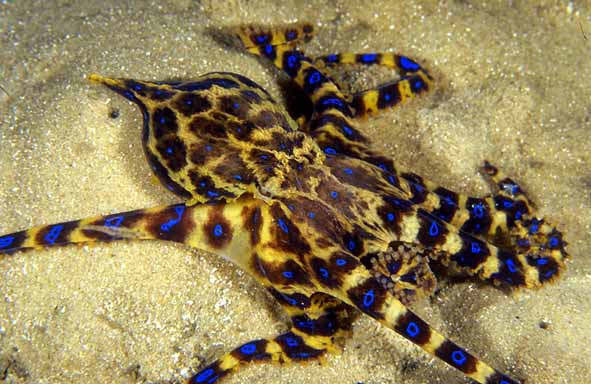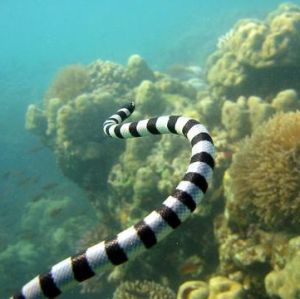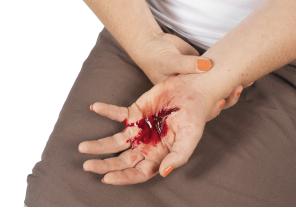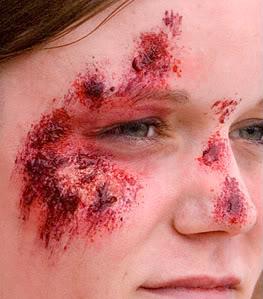Blue-ringed octopus
 The blue-ringed octopus is an attractive little creature that lives in rock pools on the shores of Australia. When threatened, the creature 'pulses' luminous bright blue rings on its body. Its bite is painless and will only occur if the creature is handled.
The blue-ringed octopus is an attractive little creature that lives in rock pools on the shores of Australia. When threatened, the creature 'pulses' luminous bright blue rings on its body. Its bite is painless and will only occur if the creature is handled.
Signs and symptoms
- A spot of blood
- Numb feeling of the face and tongue
- Progressive weakness in the legs and body
- Eventual collapse
- Respiratory arrest
- Reassure
- Pressure immobilisation bandage
- Call ambulance urgently
- Rescue breaths as required
Cone shell
The cone shell is a variegated shell, usually brown and white, which is common on tropical beaches. The shell contains a dagger-like spine, which can inject toxin into any unwary person who handles the creature.
Signs and symptoms:
- A spot of blood
- Numb feeling of the face and tongue
- Progressive weakness in the legs and body
- Eventual collapse
- Respiratory arrest
Care and treatment:
- As for blue-ringed octopus
Portuguese man-of-war ('bluebottle')
The Portuguese man-of-war or 'bluebottle', found on most beaches in Australia, is really a colony of small creatures living as one. The creatures have small stinging cells which, when encountered as a group, impart a venomous sting. People who are susceptible to bee sting are usually sensitive to bluebottle venom.
Signs and symptoms:
- 'Trails' of blue 'tentacles' adhering to the body or limbs
- Stinging sensation associated with the contact
- Reddening of the skin
- Pain for some hours
- May cause severe allergic reaction (rare)
Care and treatment:
- Reassure
- Remove the 'tentacles' with a copious amount of sea water
- HOT water immersion of the site to relieve pain - ensure the water will not scald the casualty
- If hot water fails, then a dry cold compress may relieve pain
- Call ambulance or own doctor
- If severe allergic reaction: - call Triple Zero (000) for an ambulance
Sea snakes
 Sea snakes may grow to be several metres in length and are found mainly in warmer waters. They appear similar to land snakes, but have flatter tails.
Sea snakes may grow to be several metres in length and are found mainly in warmer waters. They appear similar to land snakes, but have flatter tails.
Signs and symptoms:
- Relatively painless
- Drowsiness
- Weakness
- Nausea and vomiting
- Breathing difficulties
- Visual disturbances
Care and treatment:
- As for snakebite
Bleeding and shock
The body must have enough circulating blood volume to keep the body functioning and keep the organs supplied with oxygen. Blood consists of red cells, which convey oxygen throughout the body; white cells, which fight introduced infection; platelets, which assist in the clotting process; and plasma, the fluid portion of blood. There are between five and seven litres of blood in the average adult body which makes up 7-8% of the body weight.
Blood is moved around the body under pressure by the heart and blood vessels. Without an adequate blood volume and pressure, the human body soon collapses. Bleeding or hemorrhage, poses a threat by causing both the volume and the pressure of the blood within the body to decrease through blood loss when blood vessels rupture due to a severe injury.
Bleeding is one of the common causes of death in accidents. The aim of the first aider is to reduce the loss of blood from the casualty.
External bleeding
 External bleeding is usually associated with wounds. Serious wounds involve damage to blood vessels. Damage to an artery is characterised by bright red blood which can spurt with each heartbeat. Damage to veins appears as a darker red and tends to flow.
External bleeding is usually associated with wounds. Serious wounds involve damage to blood vessels. Damage to an artery is characterised by bright red blood which can spurt with each heartbeat. Damage to veins appears as a darker red and tends to flow.
Capillary damage is associated with wounds close to the skin and is a bright red and oozes.
A wound is caused when our body tissue is torn or cut. Types of wounds include abrasions, amputations, incisions, lacerations and punctures.
 Abrasion
Abrasion
Is a wound where the skin layers have been scraped off from a fall on a rough surface, pieces of shells, claws of animals, machinery, etc? These wounds have torn or irregular edges and they tend to bleed less.
Amputation
Is the severing or partial severing of part of the body, such as a limb or part of a limb.
Incision
Is a wound characterised by 'slicing' as with a sharp knife or sharp piece of metal. It is often characterised by a narrow wound which has cut cleanly and bleeds extensively.
Laceration
Is a jagged-edge wound with associated tissue loss, such as from a barbed wire fence injury or where a rider's ankles, knees, elbows or wrists have abraded at speed, colliding with a road surface.
Puncture
Wounds are perforations, from anything from a corkscrew to a bullet and generally with a limited external area but potentially quite deep, affecting internal organs. Some bleeding, such as varicose veins, can often rupture with little or no injury.
Life threatening bleeding
- Call Triple Zero (000) for an ambulance
- Put on disposable gloves if available
- Remove or cut clothing to expose the wound
- Check the wound for visible foreign bodies
- Apply direct pressure over the wound with a sterile or clean pad - the casualty may be able to apply direct pressure themselves
- Lie the casualty down if not already in this position
- Raise and support the injured part above the level of the heart if possible
- Apply a dressing and a firm bandage to hold the pad in place - check circulation - reassess circulation every 30 minutes
- Treat for shock if required
- Check circulation regularly to ensure bandage is not too tight
- Regularly monitor and record level of consciousness, pulse and breathing If unable to stop the bleeding consider a constrictive bandage
- Cut or remove all clothing from the upper part of the affected limb
- Select a firm wide bandage (minimum 5 cm) that is not too elastic
- Apply bandage firmly to limb and tighten until bleeding stops
Do not cover the bandage - ensure that the constrictive bandage remains easily seen. Constrictive bandages are a measure of last resort and should only be used in a life threatening situation where all other methods have failed.
- Bleeding from wounds
- Put on disposable gloves if available
- Check the wound for foreign matter
- Immediately apply pressure to stop any bleeding
- Bring the sides of the wound together and press firmly
- If a penetrating object is present - build up padding around the object for bleeding control and support - apply a firm roller or triangular bandage to support padding
- Apply a non-stick dressing and a firm roller bandage
- Immobilise and elevate the injured limb if injuries permit
- Do not remove any penetrating object
- Do not put pressure over penetrating object